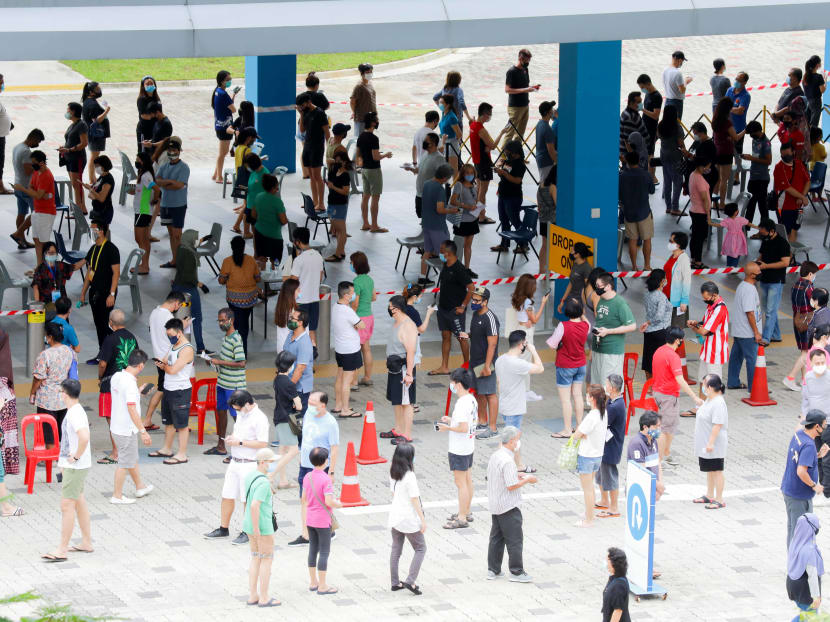Elections Department pledges changes to future election process as survey shows 3 in 10 voters unsatisfied with GE2020
SINGAPORE — The Elections Department (ELD) will review the use of voting time-bands, reduce the number of voters at larger polling stations as well as keep more manpower and equipment in reserve for future elections, it said in a statement on Thursday (Sept 10).
- ELD had embarked on a thorough review of its processes following GE2020
- Safe management measures, large polling stations aggravated queue situation
- Use of voting time-bands to be relooked at, as voter turnout not spread evenly on Polling Day
- A survey found that three in 10 voters were dissatisfied. This is unacceptable, says ELD
SINGAPORE — The Elections Department (ELD) will review the use of voting time-bands, reduce the number of voters at larger polling stations as well as keep more manpower and equipment in reserve for future elections, it said in a statement on Thursday (Sept 10).
“In retrospect, we should not have concentrated all senior voters in the morning. Going forward, we will see how best to spread out senior and non-senior voters across time-bands,” it said.
The ELD’s statement comes after it conducted a thorough review to understand why there were “abnormally long queues” at some polling stations in the July General Election (GE) and the lessons that can be drawn for future elections.
On July 10, which was Polling Day, 199 out of a total of 1,097 polling stations — or 18 per cent — had experienced longer-than-usual queues in the morning. Around 4 per cent of all polling stations saw sustained long queues throughout the day.
Voting hours were extended by two hours until 10pm to accommodate the longer-than-expected queues, which was the first polling time extension in Singapore’s election history.
The review found that one-third of voters in the morning were non-senior voters, even though that time belt had been allocated to senior voters.
As a result, the allocated time-bands did not succeed in spreading out the voter turnout evenly through the day, ELD said.
The higher concentration of senior voters in the morning also slowed down voter flow, because more of them required support and assistance from election officials.
“Should ELD decide to continue with time-band allocation, fewer voters will be allocated in the morning, to provide a comfortable buffer for other voters who vote outside their time-band, as the morning window is generally preferred by voters,” it added.
RESOURCES AT LARGE POLLING STATIONS
For future elections, ELD will also look to reduce the number of voters at large polling stations wherever feasible.
During the recent GE, some large polling stations in schools and community clubs could not be split into two polling stations feasibly, unlike how it was done in certain void decks of public housing blocks.
Out of all the polling stations, 25 had more than 4,400 voters, out of which 22 experienced long voter queues. The average number of voters at each polling station was 2,400.
“These 25 large polling stations should have been better-resourced, for example with more election officials or e-registration devices,” ELD said.
A total of 36,000 election officials were deployed for GE2020, around 20 per cent more than in GE2015. The number of polling stations had also been increased from 832 in GE2015.
In future, more election officials and equipment will be deployed in large polling stations. ELD will also increase the reserve pool of election officials who can be deployed quickly to handle contingencies, including any unforeseen build-ups in queues.
More e-registration devices — which allowed voters to self-scan their identity cards — will also be provided as they had generally sped up the registration process, ELD noted.
It added that there were some delays due to voters’ unfamiliarity with the devices, and ELD could not carry out community roadshows before that due to Covid-19. The devices were used for the first time in GE2020.
“For GE2020, the procurement of e-registration devices was done before Covid-19, and the vendor could not supply more devices to create a comfortable buffer in time to match the increased number of polling stations due to the Covid-19 situation.”
The safe management measures — such as temperature taking, putting on disposable gloves and hand sanitising — had also caused delays, the review found.
To reduce the waiting time, in the early part of the morning of Polling Day, ELD did away with the requirement to wear disposable gloves since voters would have already sanitised their hands, it said. This improved the queue situation significantly by 11am.
“Nevertheless, the other necessary precautionary measures (temperature taking, hand sanitisation and ensuring safe distancing among voters) meant that voters, in general, spent a longer time to queue and vote, as compared with past elections.”
VOTER SATISFACTION AND WAITING TIMES
To gauge voters’ experience with the polling process in GE2020 and identify areas for improvement, ELD conducted a survey with the aid of government feedback unit Reach.
About 80 per cent of voters surveyed said that they spent less than 30 minutes to vote, while about 9 per cent said that they took 45 minutes or more.
“Voter satisfaction decreased significantly with increasing time voters took to cast their vote, with a ‘cliff effect’ observed when the voting time reached 30 minutes,” ELD said.
While 84 per cent of the voters who took less than 10 minutes to vote agreed that they were satisfied with their overall polling experience, only 54 per cent of voters who took 30 to 44 minutes were satisfied. Around 10 per cent who took more than an hour to vote were happy with the process.
The survey, however, found an overall high satisfaction with the polling process and the conduct of election officials:
78 per cent of the voters agreed that the polling process was well organised, 17 per cent were neutral and 4 per cent disagreed
77 per cent of voters agreed that the election officials were helpful to voters when carrying out their election duties, 20 per cent were neutral and 4 per cent disagreed
Overall, 7 out of 10 voters were satisfied with their experience at the polling stations
Those who voted at schools and community centres or clubs registered a poorer voting experience because of the length of time it took to vote
ELD said: “Even though the Reach poll found that seven in 10 voters were satisfied with their experience at the polling stations, that three in 10 voters had a less than satisfactory voting experience is not acceptable.
“We apologise for this and thank voters for their patience. We would like to assure voters that ELD will improve our systems and processes as we prepare for future elections.”









